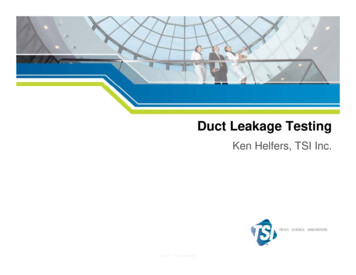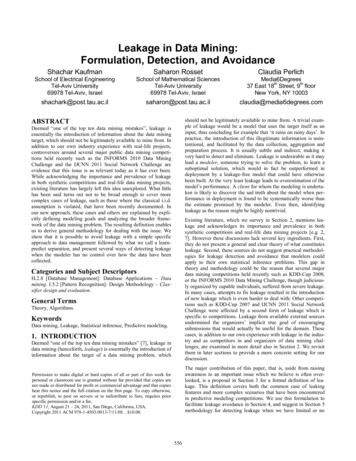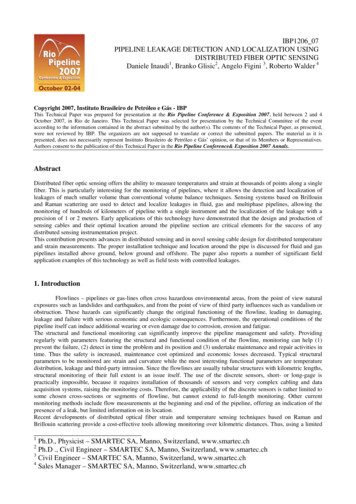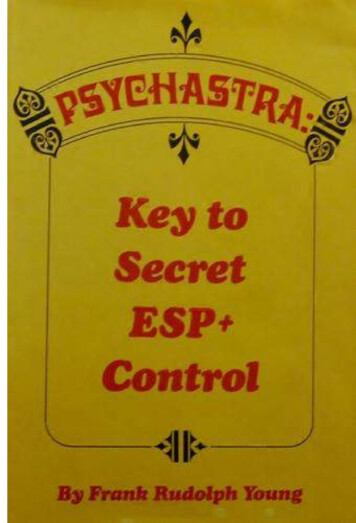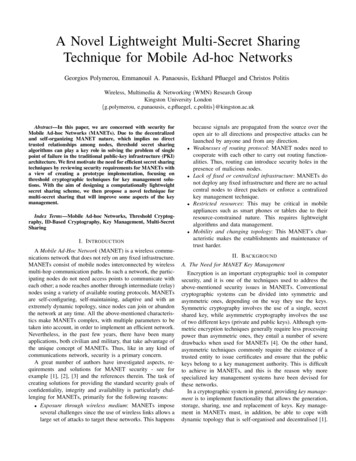
Transcription
Secret Key Leakage from Public KeyPerturbation of DLP-based CryptosystemsAlexandre Berzati1,2 , Cécile Canovas-Dumas1 , Louis Goubin21CEA-LETI/MINATEC, 17 rue des Martyrs, 38054 Grenoble Cedex 9, sailles Saint-Quentin-en-Yvelines University,45 Avenue des Etats-Unis, 78035 Versailles Cedex, FranceLouis.Goubin@prism.uvsq.frAbstract. Finding efficient countermeasures for cryptosystems againstfault attacks is challenged by a constant discovery of flaws in designs.Even elements, such as public keys, that do not seem critical must beprotected. From the attacks against RSA [5,4], we develop a new attackof DLP-based cryptosystems, built in addition on a lattice analysis [26]to recover DSA public keys from partially known nonces. Based on a realistic fault model, our attack only requires 16 faulty signatures to recovera 160-bit DSA secret key within a few minutes on a standard PC. Theseresults significantly improves the previous public element fault attack inthe context of DLP-based cryptosystems [22].Keywords: DSA, exponentiation, fault injection, public modulus, lattice reduction.1IntroductionSince the advent of side channel attacks, classical cryptanalysis is no longersufficient to ensure the security of cryptographic algorithms. In practice, the implementation of algorithms on electronic devices is a potential source of leakagethat an attacker can use to completely break a system [23,14,18]. The injectionof faults during the execution of cryptographic algorithm is considered as an intrusive side channel method because secret information may leak from maliciousmodifications of the device’s behavior [10,11,7]. In this context, the security ofpublic key cryptosystems [10,11] and symmetric ciphers in both block [7] andstream modes [20] has been challenged.Recently, some interesting results have been obtained by attacking public keycryptosystems. More precisely, several papers demonstrated that the perturbation of public elements may induce critical flaws in implementations of publickey cryptosystems [6,13,22]. Whereas very efficient fault attacks against publicelements were elaborated for ECDLP (Elliptic Curve Discrete Logarithm Problem) [6] and IFP (Integer Factorisation Problem)-based algorithms [13,4], DLP(Discrete Logarithm Problem)-based algorithms seem to be less vulnerable: thebest known attack against public elements of DLP-based algorithms requires
an average of 4 · 107 and 3 · 106 faulty signatures to recover the secret key forrespectively a 160-bit DSA [27] and a 1024-bit ElGamal [17]. This amount offaults is a serious drawback to ensure the practicability of this attack [22].In this paper, we propose a new fault attack against public key elements ofDLP-based cryptosystems. It is based on both lattice analysis proposed by P.Q.Nguyen and I.E. Shparlinski [26] to recover DSA public keys from known part ofnonces and fault attacks against RSA public keys [5,4]. Under a practical faultmodel, our presented attack only requires 16 faulty signatures to recover a 160bit DSA secret key within a few minutes on a standard PC. Hence, this attacksignificantly improves previous results about perturbation of public elements inthe context of DLP-based cryptosystems [22]. Moreover, this performance provides evidence that DLP-based cryptosystems are not more resistant againstperturbation of public elements.The remainder of this paper is organized as follows: Section 2 introducesthe notations used throughout the paper for the DSA signature scheme [27]and the different implementations of the exponentiation. Section 3 describes ourfault attack against the DSA public modulus for ”Left-To-Right”-based exponentiations but the attack also works when dual implementations are used. Thedetailed evaluation of the performance of our new fault attack is provided inSection 4. Finally we conclude in Section 5 about the need for protecting publickey elements from faults.22.1BackgroundPresentation of the DSAThe Digital Signature Algorithm, or DSA, is the American federal standard fordigital signatures [27]. The system parameters are composed by {p, q, h, g} wherep stands for a large prime modulus of size n, q is a l-bit prime such that q p 1,h is a hash function and g Z p is a generator of order q. The private key is aninteger x Z q and the public key is y g x mod p. The security of DSA relieson the hardness of the discrete logarithm problem in prime finite fields and itssubgroups.Signature. To sign a message m, the signer picks a random k q and computes: h(m) xumod q.u g k mod p mod q and v kThe signature of m is the pair: (u, v).Verification. To check (u, v), the verifier ascertains that: ?u g wh(m) y wu mod p mod q, where w v 1 mod q.
2.2Modular exponentiation algorithmsBinary exponentiation algorithms are often used for computing the DSA signatures (see Sect. 2.1). Their polynomial complexity with respect to the inputlength makes them very interesting to perform modular exponentiations.The Algorithm 1 describes a way to compute modular exponentiations byscanning bits of d from least significant bits (LSB) to most significant bits(MSB). That is why it is usually referred to as the ”Right-To-Left” modularexponentiation algorithm.The dual algorithm that implements the binary modular exponentiation isthe ”Left-To-Right” exponentiation described in Algorithm 2. This algorithmscans bits of the exponent from MSB to LSB and is lighter than ”Right-To-Left”one in terms of memory consumption.Algorithm 1: ”Right-To-Left” modularexponentiationPiINPUT: g, k n 1i 0 2 · ki , pkOUTPUT: A g mod p1 : A: 1;2 : B: g;3 : for i from 0 upto (n 1)4:if (ki 1)5:A : (A · B) mod p;6:end if7:B : B 2 mod p;8 : end for9 : return A;33.1Algorithm 2: ”Left-To-Right” modularexponentiationPiINPUT: g, k n 1i 0 2 · ki , pkOUTPUT: A g mod p1 : A: 1;2 : for i from (n 1) downto 03:A : A2 mod p;4:if (ki 1)5:A : (A · g) mod p;6:end if7 : end for8 : return A;Fault Attack Against DSA signature SchemeFault ModelDescription of the model. The model we have chosen to perform the attackis inspired by the previously used by A. Berzati et al. to successfully attack both”Right-To-Left” [5] and ”Left-To-Right” [4] based implementation of standardRSA. We suppose that the attacker is able to inject a transient fault that modifiesthe public parameter p during the computation of u (see Sect. 2.1). The faultis supposed to affect randomly on byte of p such that the value of the faultymodulus p̂ is not known by the attacker, namely:p̂ p ε(1)where ε R8 · 2i , i [[0; n8 1]] and R8 is a non-zero random byte value. For thesake of clarity, we assume that the exponentiation algorithm used to implement
the first part of the signature (i.e. the computation of u) is the ”Left-To-Right”algorithm (see Sect. 2.2). The attacks also applies for ”Right-To-Left” basedimplementations of the DSA signature scheme.Discussion. This fault model has been chosen for its simplicity and practicability in smart card context, leading to successful applications [19,8,4]. Furthermore,it can be easily adapted to 16-bit or 32-bit architectures.A large number of fault model have been described in the literature. Most ofthem are listed and discussed in [9,30]. Hence from these references, the faultmodel used in [2] seems to be more restrictive than the one used in our analysissince D. Naccache et al. consider an attacker that is able to set some bytes ofk to a known value (i.e. some bytes of k are set to 0). On the contrary, ourfault model seems to be stronger than Kim et al.’s one [22]. But, although theirfault model is easier to practice, the significant number of fault required by theanalysis represents a serious drawback. As a consequence, compared to previouswork, our new fault attack is a good trade-off between practicability of the faultmodel and efficiency of the analysis.3.2Faulty ExecutionThis section details a faulty execution of the ”Left-To-Right” modular exponentiation. We supposePl 1that the fault occurs t steps before the end of the exponentiation. Let k i 0 2i · ki be the binary representation of k and A the internalregister value before the modification of p:A gPl 1i t2i t ·kimod p(2)If the first perturbed operation is a square, then the faulty first part of thesignature û can be written: 2 2A2 · g kt 1 · g kt 2 . . . g k0 mod p̂ mod qû t Pt 1 i A2 · g i 0 2 ·ki mod p̂ mod q(3)Obviously, the other part of the signature v is also infected by the fault:v̂ h(m) xûmod qk(4)One can notice from (3) that the perturbation has isolated the t least significantbits of k. The adaptation of the method described in [4] allows an attacker torecover this part of k.3.3Extraction of a part of kThe differential fault analysis against the ”Left-To-Right” implementation ofthe RSA signature, described in [4], takes advantage of the difference between
a correct and a faulty RSA signature to recover a part of the private exponent.This method can not be applied as itself to analyze the DSA faulty signaturesince k is a nonce. But, by using the properties involved in the DSA signatureverification (see Sect. 2.1), the sole knowledge of the faulty DSA signature (û, v̂)and the input message m may be sufficient to recover the least significant partof the nonce k.Getting a correct u. The correct signature part u can be obtained by usingthe trick of the DSA signature verification. Indeed, if v̂ is invertible in Z q , letŵ v̂ 1 mod q: g ŵh(m) · hŵû mod p g ŵ(h(m) xû) mod p g k mod p u(5)The advantage of this method is that it requires only the knowledge of an inputmessage and the corresponding faulty signature (û, v̂). The only condition tosatisfy is that gcd(v̂, q) 1 which is always the case since q is prime and v̂ q. Then, the attacker can compare û and u for guessing and determining thesearched part of k by applying the analysis provided in [4]. Its application to theDSA is detailed below.Guess-and-determine the part of k. The attacker aimsrecover the leastPtot 1significant part of k isolated by the fault injection kt i 0 2i · ki (see alsoSect. 3.2). Since the attacker knows that the fault occurs t steps before the endof the exponentiation and that it has randomly modified one unknown byte ofp, the attacker tries to guess both kt and p̂. Namely, the attacker chooses a pairof candidates (kt0 , p0 ) and first computes:0R(kt0 ) u · g kt mod p(6)For the sake of clarity, let us rewrite u obtained with the ”Left-To-Right” algorithm:u g k mod p t A2 · g kt mod p(7)tBy observing (6) and (7) one can notice that when kt0 kt , R(kt0 ) A2 mod p.So, R(kt0 ) is expected to be a t-th quadratic residue in Z p . Hence, if R(kt0 ) is nota quadratic residue, the attacker can directly discard kt0 . This condition is notsufficient but allows to reduce the number of computations. Since p is prime, theattacker can perform the quadratic residuosity test based on Fermat’s Theorem.Hence, R(kt0 ) is a quadratic residue ifR(kt0 ) p 12 1 mod p(8)
In this case, the attacker can compute the square roots of R(kt0 ) using the Tonelliand Shanks algorithm [15]. This step has to be repeated until the quadraticresiduosity test fails and at most t times since R(kt0 ) is expected to be a t-thquadratic residue. At first sight, one may think that computing t-th quadraticresidues of R(kt0 ) may return 2t possible values. In fact, this is not the case sincea number randomly chosen in a cyclic group has 2min(s,t) t-th quadratic residues,where s is the bigger power of 2 that divides p 1. In the general case, the powers is lower or equal to 4. The purpose of this step is to obtain a candidate valuefor the internal register Akt0 when the fault was injected.The next step consists in simulating a faulty end of execution from the chosencandidate pair (kt0 , p0 ) and the previously obtained Akt0 . Hence, the attackercomputes: t(9)u0(kt0 ,p0 ) A2kt0 · g kt mod p0 mod qFinally, to validate his guess for kt0 and p0 , the attacker checks if the followingcondition is satisfied:u0(kt0 ,p0 ) û mod q(10)According to [5,4], the satisfaction of (10) implies that the candidate pair (kt0 , p0 )is very probably the right one (see App. A) and so, the attacker directly deducesthe t-bit least significant part of k.One can notice that the quadratic residuosity tests discards a majority of kt0candidates before guessing p0 . Hence, the pair of candidate values is not simultaneously, but quite sequentially, searched. So, the practical complexity of thisstep is smaller than the theoretical one (see Sect. 4).The main advantage of this analysis compared to the one about the ”LeftTo-Right” implementation of RSA is that p̂ has not to be prime for allowing thethe attacker to compute square roots. So, only one faulty signature (û, v̂) maysuffice to recover kt .According to [5,4], we can also perform the analysis when the first perturbated operation is a multiplication (i.e. instead of a square). Moreover the faultmodel can be extended to the perturbation of a single operation during the exponentiation (i.e. such that p is error-free for subsequent operations).This fault analysis does not work only for the ”Left-To-Right” implementation of the exponentiation but also for variants based on the ”Left-To-Right”approach such that Fixed/Sliding windows [25] or the SPA-resistant ”Squareand Multiply Always” [16].3.4Extraction of the KeyThe purpose of this part is to approximate the DSA secret key x as accuratelyas possible from public values and the recovered part of nonce. In the context ofElGamal-type signature schemes, previous results demonstrated the possibilityfor retrieving the secret key from partially known nonces by using lattice reduction [21,26]. This result was later applied in the context of fault attacks [26]. Thefollowing parts briefly describe how lattice attack works for obtaining the secret
key from previously recovered t-bit least significant part of k. This descriptionis inspired from the work of P.Q. Nguyen and I.E. Shparlinski [26].Lattice attacks exploit the linearity of the second part of the faulty signature, namely: v̂ h(m) xûmod q. The partial knowledge of the nonce k causeskan information leakage from v̂ about the private key x. As a consequence, bycollecting sufficiently many faulty signatures and recovering corresponding partsof k, the attacker will be able to recover x.Let kt be the t-bit recovered part of a nonce k and r 0 the unknown part.Then, we have k r2t kt . As previously mentioned, the lattice attack takesadvantage of the second part of the faulty signature, that can be written as:xû kv̂ h(m) mod qIf v̂ 6 0, we can also write xûv̂ 1 2 t kt v̂ 1 h(m) 2 t r mod q(11)Let us define the two following elements:a ûv̂ 1 2 t mod q b kt v̂ 1 h(m) 2 t mod qHence, from (11), we also have:xa b r mod q(12)Since 0 r q/2t , λ Z such that:0 xa b λq q/2t(13) xa b q/2t 1 λq q/2t 1(14)And then:From the equation below, the attacker gets an approximation of xa modulo q byc b q/2t 1 . We can notice that the more t is high and the more accurate isthe approximation. But, to apply the lattice attack and determine the secret keyx, the attacker needs sufficiently many approximations. Now, suppose that theattacker has collected d faulty DSA signatures (ûi , vˆi )1 i d and recovered foreach one kit , the t-bit least significant part of the corresponding nonce ki (seeSect. 3.3). From these values, he can also compute ai and ci such that, λi Z: xai ci λi q q/2t 1(15)The problem of recovering the secret key x from this set of equations is similarto the hidden number problem introduced by D. Boneh and R. Venkatesan [12].This problem can be solved by transforming it into a lattice closest vector problem [12,26]. Indeed, consider the lattice L generated by the row vectors of the
following matrix: q 0 ··· 0 q . . . . . . . . . 0 ··· 0a1 · · · · · · 0. . . M(d 1),(d 1) (Q)0. q0 ad 1/2t 10.(16)Then the vector α (xa1 λ1 q, . . . , xad λd q, x/2t 1 ) belongs to the latticesince it can be expressed in a linear combination of the row vectors:α dXλi Li xLd 1(17)i 1where Li stands for the i-th row vector of the matrix. The vector α is alsoreferred as the hidden vector because its last coordinate (i.e. x/2t 1 ) directlydepends on the hidden number x. From the set of equations obtained with faultyDSA signatures (see Eq. 15), the hidden vector is approximated by the vectorβ (c1 , . . . , cd , 0). β does not belong in the lattice but its coordinates canbe computed by the attacker since it relies only on public information and therecovered part of nonce (kit )1 i d . To find x, the attacker tries to find the closestvector to β that belongs to the lattice L. If the lattice matrix is transformed to anLLL-reduced basis [24], then it is possible to solve an appoximated instance of theclosest vector problem in a polynomial time using the Babai’s algorithm [3,29].Once the closest vector is found, the attacker derives from its last coordinatea candidate value for the secret key x0 . Finally, to check the correctness of thesolution, the attacker has to check if the following condition is satisfied:0g x y mod p(18)The success rate of the lattice attack depends on d, number of faulty signatures to gather, and t, size of nonce recovered. According to [26,2], d l/t faultysignatures may suffice to recover x (i.e. l corresponds to the size of q). Our experimental results emphasise this evaluation. Furthermore, one can notice that theattacker can exploit faulty signatures perturbated at different steps ti before theend of the exponentiation. In this case, the attacker has to collect d l/min (ti )ifaulty signatures to succeed in the lattice attack.Finally, this analysis can be easily adapted to attack ”Right-To-Left-basedimplementations of DSA. In this case, the attacker also exploit faults on p thathas been injected t steps before the end of the exponentiation to recover mostsignificant bits of k. But, if q is close to 2l 1 , the most significant bit of k mayoften be equal 0. To avoid this loss of information, D. Boneh and R. Venkatesan [12] proposed to use another representation for the MSB referred as mostsignificant modular bits MSMB [26]. By using this representation, the attackeronly has to slightly adapt the previous analysis to exploit the recovered mostsignificant parts of random.
3.5Attack algorithmOur fault attack against the public parameters of the DSA signature scheme canbe dividing in five distinguishable steps that have been presented throughout thepaper. This section provides a summary of the attack that lists these differentsteps.Step 1: Gather d faulty DSA signatures by modifying the public parameter pat t step before the end of the computation of u. The number of signaturesto gather depends on the size of DSA but, in general d l/t,Step 2: For each faulty signature (ûi , vˆi ), recover the t-bit part of the corresponding nonce ki using the fault analysis of Section 3.3,Step 3: From the set of faulty signatures (ûi , vˆi )1 i d and the parts of nonce(ki )1 i d , the attacker computes the lattice matrix and the public approximation vector β (see Sect.3.4),Step 4: The attacker applies the LLL-reduction [24] to find a reduce basis forthe lattice. Then, he uses the Babai’s polynomial algorithm [3] to obtain theclosest vector to β that belongs in the lattice.Step 5: Finally, the attacker extracts a secret key candidate from the last coordinate of this vector and checks if it is the right key (see Eq. (18)).4PerformanceIn order to compare the performance of our brand new fault attack against DSApublic parameters, we will give a theoretical evaluation of its performance interms of fault number and computational complexity.4.1Theoretical EvaluationFault Number. In this section, we evaluate the number of faults N requiredto recover the secret key. According to the model chosen (see Sect. 3.1), eachfault injection results to an exploitable faulty output. Hence, since one part ofnonce may be obtained from one faulty DSA signature (see sect. A), N can beapproximated by the number of faulty signatures to gather for extracting thekey (see sect. 3.4): l(19)N OtFor a 160-bit DSA with t 10 (which is a reasonable choice according to theexperimental results in Table 1), 16 faulty signatures may suffice to extract theDSA key. According to [26], the number of faults can be decreased to log l. Asa comparison, the best known fault attack against the DSA public elements [22]requires a mean of 4 · 107 faults to succeed in practice (and 2 · 108 in theory).This significant improvement is due to the difference of method employed andalso because, in our analysis, each signature modified according to the modelcan be exploited and so, brings a certain amount of information about the secretkey.
Computational complexity. In this section, we aim to evaluate the computational complexity of our fault analysis. According to Section 3.5, the overallcomplexity C of the attack can be expressed as:C CLatticeattack NXCextractkt(20)i 1First, we evaluate the complexity Cextract kt for recovering a t-bit part of noncek in the case of the ”Left-To-Right” implementation of the DSA in the theorembelow. The proof is given in Appendix B.Theorem 1. For a random byte fault assumption against the ”Left-To-Right”implementation of a DSA such that p is a n-bit prime and q (p 1) a l-bit prime,the computational complexity Cextract kt for recovering a t-bit part of the nonceis at most: Cextract kt O 25 t · n2 · t exponentiations(21)Concerning the computational complexity of the lattice attack (see Sect. 3.4),when the closest vector approximation algorithm is used, the running time issubexponential in the size of q [26,1]. However, the exploitation of faulty signatures allows to handle quite small lattices (i.e. d 20 vectors), so that thecomplexity of the lattice reduction step is negligible with respect to the extraction of all the (kt )i .As a consequence, our fault attack provides an algorithm with a running timeexponential in the parts of nonce to recover and subexponential in the size ofthe secret key. The exponential dependency in the number of bits of nonces torecover is not critical since it is a parameter set by the attacker in accordancewith his capabilities. These results have been validated experimentally (see Sect.4.2) with the NTL implementation of the Babai’s algorithm.4.2Experimental ResultsIn order to evaluate the practicability of our fault attack, we have implementedthe attack algorithm described in Section 3.5 using the C NTL Library [29]against a 160-bit DSA (i.e. n 1024 bits and l 160 bits). We have generatedfaulty DSA signatures from a random message by simulating faults according tothe model (see Sect. 3.1). For the lattice attack, we have used as a lattice basisreduction algorithm the NTL implementation of Schnorr-Euchner’s BKZ algorithm [28] and the NTL implementation of the Babai’s algorithm [3] to solve theapproximated instance of CVP. The experimental results detailed below wereobtained on a Intel Core 2 Duo at 2.66 GHz with the G compiler. First, wehave estimated the time to extract parts of the nonce, for different values of t.The computation of the average time to extract the t least significant part of anonce was obtained from 100 measures. These results for different values of t arepresented in Table 1. The obtained results highlight the exponential dependencyin t of the execution which emphasises our complexity analysis. As an example,
Table 1. Average time to extract t bits of nonce for a 160-bit DSAt4 bits 5 bits 6 bits 8 bits 10 bitsAverage time 16 s 33 s 1 min 4 min 30 s 17 minfor t 10 bits, it takes two hours for recovering all of the (kt )i on a dual-corePC and a few second to recover the private key with the Lattice Attack [21,26].But, these performances depend on the amount of kt bits an attacker is able torecover by analyzing faulty signatures. As shown in Table 1, the choice of thenumber of bits of nonce to recover is a tradeoff between the time of executionand the number of faults. So this parameter has to be carefully chosen in function of the attacker’s resources. Finally, one can advantageously notice that sinceFig. 1. Success rate of the lattice attack in function of window length t and faultnumber drecovering a part of nonce only requires the analysis of one faulty signature, theattacker can recover part of multiple nonces in parallel. Thus, the attacker canoptimize the fault analysis in terms of execution time.Then, we have evaluated the performance of the lattice attack. In the condition of our experiments, it takes a few seconds for recovering the 160-bit secretkey from 10-bit parts of nonces extracted from 16 signatures. Hence, the analysis algorithm is practicable even on a standard PC. The success of the attackdepends on the window length t that determines the precision of the approximation and the number of faulty signatures d that are used for building the lattice.The figure 1 presents the number of times when the attack succeeds in functionof t and d and shows that if d equals to the recommended value N 160/t theapproximation may not be sufficient when t is small. For example, if the attackerchooses to recover 6 bits of nonce because it only takes around 1 minute, with160/6 26 faults the attack only succeeds one time out of 100, but with 29
faults the gain is increased to 45%. More t and d are high, more the attack haschance of success, but increasing t takes a longer time and increasing d makesa larger lattice. Moreover reducing t implies to increase the number of faults d.So the choice of these parameters is also a tradeoff between time, ressource andfault number.5ConclusionThe methods used in the literature to attack some cryptosystems by perturbingpublic key elements can be divided into two classes. In the first class, one canmodify public elements before the computation, such that the algebraic properties of the finite fields are changed and the system becomes weaker. In thesecond class, the perturbation can come up during the execution, splitting thecomputation into two parts so as to isolate a small part of the key. The DLPbased algorithm is not an exception and this paper described a practical attackagainst DSA and El Gamal signature schemes. This attack belongs to secondclass and does not require the knowledge of a correct signature. Partial valuesof nonces are retrieved thanks to a guess-and-determine strategy and then thesecret key is derived from lattice reductions. The used fault model is the classicalbyte modification or any other model allowing the guess of a value. The simulation of the attack has shown its efficiency as it only requires 16 faulty signaturesto recover a 160-bit DSA secret key within a few minutes on a standard PC.Moreover the simulation results confirm the complexity analysis and give somedecision factor for the choice of the parameters.This attack underlines that it is essential to protect public elements againstfault attacks, for instance redundancy or infective techniques. The power of thelattice reduction techniques shows that even a small leakage of information canreveal secret information, even if it does not seem sufficient at first sight. Therefore, lattice reduction algorithms must be also be seriously taken in account inthe context of fault attacks.References1. M. Ajtai, R. Kumar, and D. Sivakumar. A Sieve Algorithm for the Shortest LatticeVector Problem. In ACM Symposium on Theory on Computation (STOC 2001),pages 601–610, 2001.2. F. Armknecht and W. Meier. Fault Attacks on Combiners with Memory. InB. Preneel and S. E. Tavares, editors, Selected Areas in Cryptography (SAC 2005),volume 3897 of Lecture Notes in Computer Science. Springer, 2006.3. L. Babai. On Lovász lattice reduction and the nearest point problem. Combinatorica, 6:1–13, 1986.4. A. Berzati, C. Canovas, J-G. Dumas, and L. Goubin. Fault Attacks on RSAPublic Keys: Left-To-Right Implementations are also Vulnerable. In M. Fischlin,editor, RSA Cryptographer’s Track (CT-RSA 2009), volume 5473 of Lecture Notesin Computer Science, pages 414–428, San Francisco (USA), 2009. Springer.
5. A. Berzati, C. Canovas, and L. Goubin. Perturbating RSA Public Keys: an Improved Attack. In Cryptographic Hardware and Embedded Systems (CHES 2008),Lecture Notes in Computer Science, Washington DC (USA), 2008. Springer-Verlag.6. I. Biehl, B. Meyer, and V. Müller. Differential Fault Attacks on Ellitic Curve Cryptosystems. In M. Bellare, editor, Advances in Cryptology (CRYPTO 2000), volume1880 of Lecture Notes in Computer Science, pages 131–146. Springer-Verlag, 2000.7. E. Biham and A. Shamir. Differential Fault Analysis of Secret Key Cryptosystems.In Advances in Cryptology (CRYPTO 1997), 1997.8. J. Blömer and M. Otto. Wagner’s Attack on a secure CRT-RSA Algorithm Reconsidered. In L. Breveglieri, I. Koren, D. Naccache, and J-P. Seifert, editors, FaultDiagnosis and Tolerance in Cryptography (FDTC 2006), volume 4236 of LectureNotes in Computer Science, pages 13–23. Springer-Verlag, 2006.9. J. Blömer, M. Otto, and J-P. Seifert. A New CRT-RSA Algorithm Secure AgainstBellcore Attack. In ACM Conference on Computer and Communication Security(CCS 2003), pages 311–320. ACM Press, 2003.10. D. Boneh, R.A. DeMillo, and R.J. Lipton. On the Importance of Checking Cryptographic Protocols for Faults. In W. Fumy, editor, EUROCRYPT’97, volume 1233of Lecture Notes in Computer Science, pages 37–51. Springer-Verlag, 1997.11. D. Boneh, R.A. DeMillo, and R.J. Lipton. ”On the Importance of EliminatingErrors in Cryptographic Computations”. Journal of Cryptology, 14(2):101–119,2001.12. D. Boneh and R. Venkatesan. Hardness of Computing the Most Significant Bitsof Secret Keys in Diffie-Hellman and Related Schemes. In Advances i
Secret Key Leakage from Public Key Perturbation of DLP-based Cryptosystems Alexandre Berzati 1; 2, C ecile Canovas-Dumas , Louis Goubin 1 CEA-LETI/MINATEC, 17 rue des Martyrs, 38054 Grenoble Cedex 9, France, falexandre.berzati,cecile.dumasg@cea.fr 2 Versailles Saint-Quentin-en-Yvelines University, 45 Avenue des Etats-Unis, 78035 Versailles Cedex, France



